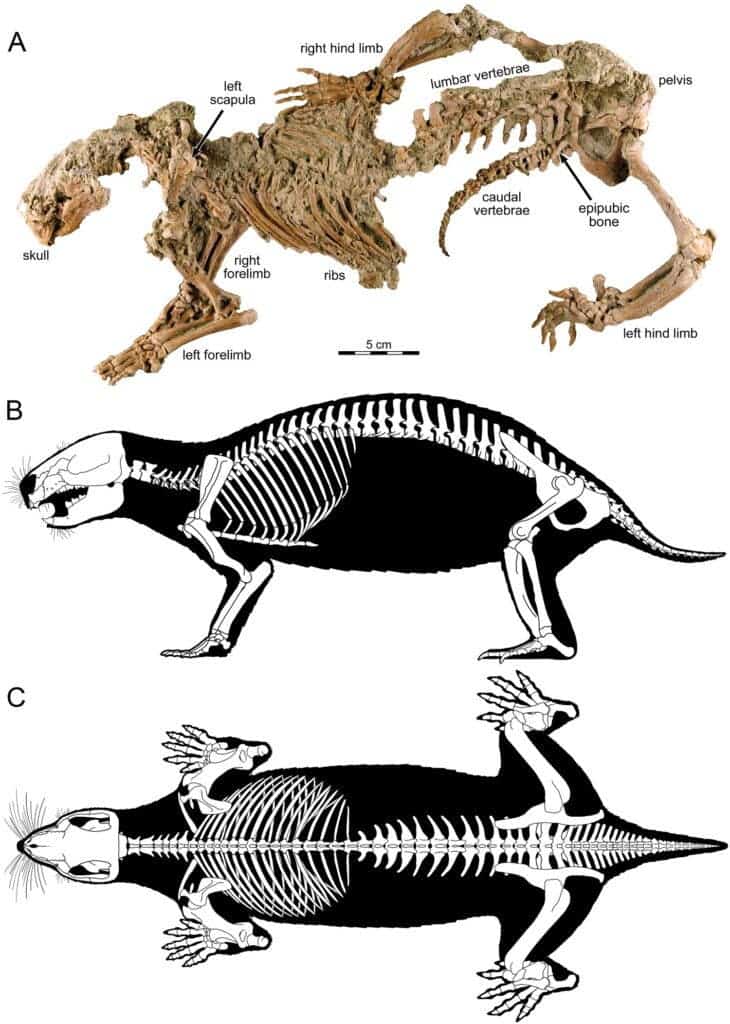New research sheds light on a 66-million-year-old mammal that lived alongside the dinosaurs. The findings help us better understand the evolutionary history of mammals from the southern supercontinent Gondwana — today’s Africa, South America, Australia, Antarctica, India, and Arabian Peninsula.

Christened Adalatherium hui, which is a combination of Malagasy and Greek meaning “crazy beast,” the paper describes this new species based on an almost complete, excellently-preserved fossil skeleton. The authors explain that this specimen is the most complete for any mammal yet discovered in the southern hemisphere from the time of the dinosaurs.
Oldboy
Research on the fossil specimen was carried out over a period of 20 years or so. In its day, the opossum-sized animal was a giant of its family, as most mammals at the time were mouse-sized. It lived on Madagascar near the end of the Cretaceous period (145-66 million years ago). At first glance, it looks quite like a badger, but that similarity is only skin-deep, the team explains.
“Adalatherium is simply odd. Trying to figure out how it moved, for instance, was challenging because its front end is telling us a completely different story than its back end” says Dr David Krause of the Denver Museum of Nature & Science, co-lead author of the paper.
“Knowing what we know about the skeletal anatomy of all living and extinct mammals, it is difficult to imagine that a mammal like Adalatherium could have evolved; it bends and even breaks a lot of rules”.
The bizarre features Dr Krause makes mention of include a greater number of vertebrae in the animal’s torso than in other mammals, a strange limb arrangement — crocodile-like hind legs with sprinting front legs that could be tucked underneath the animal as in modern mammals — front teeth like those of rabbits but back teeth that are completely unique. It was all topped off with a strange gap in the bones at the top of the animal’s snout.
Adalatherium belongs to an extinct group of mammals known as gondwanatherians, known since around the 1980s. We’ve only known the group from small fragments such as teeth and bits of jawbone, but even these showed that the gondwanatherians were strikingly different from today’s mammals. But we didn’t know where they fit in the larger tree of life due to this lack of material.
The discovery of Adalatherium thus represents a massive break for our understanding of gondwanatherians. It is the first reliable evidence of the shape and structure of this family of mammals, and will help us piece together how they went about their lives. For example, its hind legs seem tailored to digging, but its front legs are indicative of an animal that evolved to run at great speeds.
Its teeth are indicative of a herbivore lifestyle, computer micro-tomography imaging revealed, but the structure of its back teeth is unlike that of any mammal, fossil or alive, ever seen. The authors admit that they have no clue why they’re shaped the way they are, or for what purpose.
All in all, the animal likely grew to about 3.1kgs in its adult years. While it lived, Madagascar had already been separated from Africa for over 150 million years and from the Indian subcontinent for over 20 million years.
“Islands are the stuff of weirdness,” says Krause, “and there was therefore ample time for Adalatherium to develop its many extraordinarily peculiar features in isolation.
“Adalatherium is an important piece in a very large puzzle on early mammalian evolution in the southern hemisphere, one in which most of the other pieces are still missing,” adds Hoffmann.
The paper “Introduction to Adalatherium hui (Gondwanatheria, Mammalia) from the Late Cretaceous of Madagascar” has been published in the Journal of Vertebrate Paleontology.
Was this helpful?



